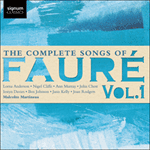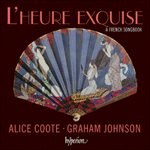The poem follows
Notre amour in Silvestre’s collection entitled
Les ailes d’or. It inspires a powerful song that is often compared to Schubert’s
Erlkönig because of the challenging octave repetitions of the piano-writing. There is a romantic grandiloquence about this music, one might even call it melodramatic, which is not native to the composer. Because Fauré so seldom allows himself to become passionate in this manner,
Fleur jetée is a useful foil for the more introverted mélodies when performers plan a group of contrasting Fauré songs. It is rare to find an instance where Fauré’s teacher Camille Saint-Saëns has actually exerted an influence on his pupil, but the piano-writing here, requiring both exact adherence to the tempo and clarity in its repetitive articulation, reminds us of the robust demands of certain passages in the Saint-Saëns piano concertos (speed up the accompaniment to Dalila’s aria,
Mon cœur s’ouvre à ta voix, and you will find similarities with the stave-hopping piano-writing of the whole central portion of
Fleur jetée). The voice too, as in some of Saint-Saëns’ songs, is unafraid to flirt with an operatic scale and manner that easily becomes ‘ham’ in the hands of less refined singers. There are, nevertheless, details a-plenty to admire; the seamless harmonic progress of the music sweeps us along and blows us away, ‘au gré du vent’, in one great
courbe. As in
Notre amour, the pulsating right-hand accompaniment is interlaced with ascending and descending scale passages in the left hand. Towards the end the time signature changes for three bars from 6/8 to 9/8 – an indication of how well Fauré understood the voice, and the expanded space that it needs to manoeuvre at the top of the stave. A polished performance of
Fleur jetée can be thrilling, but too often the public remembers only the final high notes, and the thundering postlude where the pianist always risks landing on a split chord at the last hurdle.
from notes by Graham Johnson © 2005
Ce poème, qui suit
Notre amour dans le recueil de Silvestre intitulé
Les ailes d’or, inspira une mélodie puissante, souvent comparée à l’
Erlkönig de Schubert, à cause des exigeantes reprises à l’octave de son écriture pianistique. Il émane de cette musique une grandiloquence romantique, mélodramatique presque, qui n’est pas innée chez Fauré. Parce que ce compositeur se laisse rarement gagner par une telle flamme,
Fleur jetée fait, pour les interprètes qui veulent un ensemble de mélodies fauréennes contrastées, un utile repoussoir aux pièces plus introverties. Rares sont les œuvres où Camille Saint-Saëns a véritablement influencé son élève Fauré, mais ici l’écriture pianistique, qui requiert parfait respect du tempo et limpidité dans l’articulation répétitive, nous rappelle les solides exigences de certains passages de ses concertos pour piano (accélérez l’accompagnement dans l’aria de Dalila,
Mon cœur s’ouvre à ta voix, et vous découvrirez des similitudes avec l’écriture pianistique, passant d’une portée à l’autre, de tout l’épisode central de
Fleur jetée.) Comme dans certaines mélodies de Saint-Saëns, la voix ne craint pas, non plus, de frayer avec une gamme et une manière opératiques, qui tournent vite au cabotinage entre les mains d’interprètes peu raffinés. Cette œuvre n’en regorge pas moins de détails admirables; la progression harmonique homogène de la musique nous entraîne et nous emporte «au gré du vent», en une grande courbe. Comme dans
Notre amour, l’accompagnement lancinant à la main droite est entremêlé de passages en gamme descendants et ascendants à la main gauche. Vers la fin, le signe de la mesure passe, pendant trois mesures, de 6/8 à 9/8—preuve que Fauré comprenait bien la voix et l’espace étoffé dont elle a besoin pour manœuvrer en haut de la portée. Une exécution raffinée de
Fleur jetée peut se révéler passionnante, mais, trop souvent, le public se rappelle juste les dernières notes aiguës et le postlude tonitruant, où le pianiste manque toujours de finir sa course sur un accord divisé.
extrait des notes rédigées par Graham Johnson © 2005
Français: Hypérion


 Fauré: The Complete Songs, Vol. 1
Fauré: The Complete Songs, Vol. 1 L'heure exquise
L'heure exquise Of ladies and love
Of ladies and love
